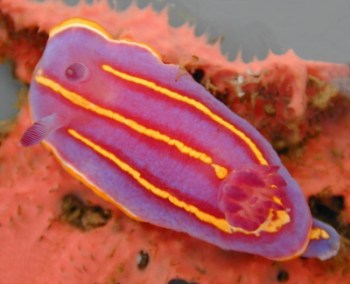Sponge prey of Chromodoris macfarlandi
June 5, 2000
From: Jeff Goddard

Chromodoris macfarlandi was recently found to prey on two species of aplysillid sponges, the pink colored Aplysilla glacialis (shown here with a 24 mm long specimen of C. macfarlandi from Bird Rock, La Jolla, California) and the deep violet colored A. polyraphis (Goddard, 2000; Mahan, 2000). Field observations and a laboratory preference test (Goddard, 2000) suggest that C. macfarlandi prefer A. polyraphis to A. glacialis. Chromodoris macfarlandi may acquire its brilliant coloration from one or both of these species.
Feeding by Chromodoris macfarlandi on at least two species of aplysillid sponges previously had been inferred by Molinski & Faulkner (1986) based on two pieces of biochemical evidence. First, the structural similarity of secondary metabolites isolated from C. macfarlandi to ones previously isolated from an Australian aplysillid, Aplysilla sulphurea, and second, the differing ratios of these metabolites in different individuals of the nudibranch.
Previous references to Chromodoris macfarlandi feeding on the spiculate sponges, Gellius sp. and Haliclona sp. (Bloom, 1976; McDonald & Nybakken, 1978) are in error and actually apply to Hypselodoris californiensis (Bergh, 1879) (see McBeth, 1970, 1971).
References:
• Bloom, S. A. (1976) Morphological correlation between dorid nudibranch predators and sponge prey. The Veliger 18(3): 289-301.
• Goddard, J.H.R. (2000) Sponge prey of Chromodoris macfarlandi. Opisthobranch Newsletter 26(2): 9-10.
• Mahan, M. (2000) Field Notes. Opisthobranch Newslette,r 26(1): 1.
• McBeth, J.W. (1970) The deposition and biochemistry of carotenoid pigments in nudibranchiate molluscs. Ph.D. dissertation, University of California, San Diego.
• McBeth, J.W. (1971) Studies on the food of nudibranchs. The Veliger, 14(2): 158-161.
• McDonald, G.R. & J.W. Nybakken. (1978) Additional notes on the food of some California nudibranchs with a summary of known food habits of California species. The Veliger, 21(1): 110-119.
• Molinski, T.F. & D. J. Faulkner. (1986) Three new rearranged spongin diterpenes from Chromodoris macfarlandi: reappraisal of the structures of dendrillolides A and B. Journal of Organic Chemistry, 51: 4564-4567.
Jeff Goddard
goddard@lifesci.ucsb.edu
Goddard, J., 2000 (Jun 5) Sponge prey of Chromodoris macfarlandi. [Message in] Sea Slug Forum. Australian Museum, Sydney. Available from http://www.seaslugforum.net/find/2499Dear Jeff,
Thanks very much for the interesting observations on feeding in Chromodoris macfarlandi. Comparative and ecological studies on sponge feeding nudibranchs is greatly hampered by the difficulty in getting sponges correctly identified, especially when many look very similar to even the expert and confirmation requires mounting and examination of the spicules in spiculate species and spongin fibres and even biochemistry in those lacking spicules. It would certainly be interesting to check the sponges Hypselodoris californiensis feeds on because if it does feed on Haliclona it would be the first chromodorid I know of that does. I am afraid many sponges have been identified as "Haliclona" in the past, but few identifications stand a thorough examination. One classic example is a southeastern Australian species Noumea haliclona which will be cursed for all time with this name because its food was incorrectly identified as Haliclona. I am preparing some pages on this species at present in which I will show photos of it on a variety of species of aplysillid sponges, on which it feeds.
Have you any references to work on chromodorids acquiring colour pigments from their food sponges? Certainly some species, such as Noumea simplex and Verconia verconis, are very similar in colour to their food sponges, but that could be through colour selection rather than through the acquisition of prey pigments.
One other point I noticed was the bright outer yellow and white inner border to the mantle. Dave Behrens [Pacific Coast Nudibranchs (1980)] has a photo of an animal with only a white border. Is the yellow border variable?
Best wishes,
Bill Rudman.
Related messages
-
Chromodoris macfarlandi from California coast
From: Ken Tucker, February 7, 2007 -
Chromodoris macfarlandi? from California
From: Josiah Renfree, June 10, 2006 -
Mating Chromodoris macfarlandi
From: Kevin Lee, March 13, 2006 -
Chromodoris macfarlandi from California
From: Chris Grossman, July 28, 2005 -
Chromodoris macfarlandi from California
From: Bruce Wight, August 6, 2004 -
Information on Chromodoris macfarlandi
From: Annalise Trepanier, February 12, 2002 -
Chromodoris macfarlandi on Aplysilla polyraphis
From: Jeff Goddard, June 13, 2000
